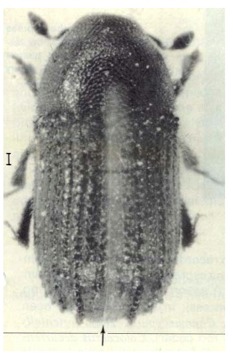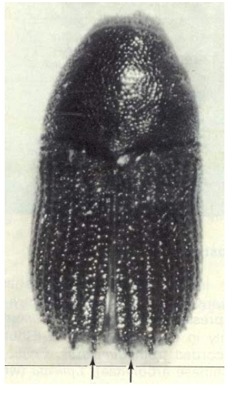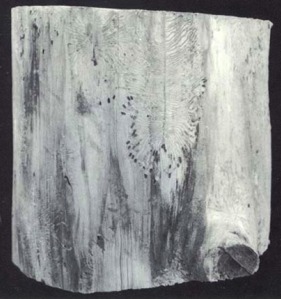PESTS AND DISEASES OF FORESTRY IN NEW ZEALAND
Phloeosinus cupressi, the Cypress Bark Beetle
Scion is the leading provider of forest-related knowledge in New Zealand
Formerly known as the Forest Research Institute, Scion has been a leader in research relating to forest health for over 50 years. The Rotorua-based Crown Research Institute continues to provide science that will protect all forests from damage caused by insect pests, pathogens and weeds. The information presented below arises from these research activities.
Forest and Timber Insects in New Zealand No. 3: Cypress barkbeetle
Revised 2009
Based on R. Zondag (1976)
Insect: Phloeosinus cupressi Hopkins (Coleoptera: Scolytidae)

Fig. 1 - Cypress barkbeetle, male. Arrow indicates incomplete rows of tubercules.

Fig. 2 - Cypress barkbeetle, female. Arrows indicate complete rows of tubercules.
Type of injury
The cypress barkbeetle breeds under the bark of dead and dying trees but is more often found under the bark of felled trees or in dead branches. The adults feed on the inner bark and also, when newly emerged, bore into small twigs, mining down the centre and leaving only a thin shell. Such attacked twigs break off.

Fig. 3 - Workings of the cypress barkbeetle under the bark of Cupressus macrocarpa. The larval tunnels spread out from the central gallery made by the parent beetles.
Hosts
In New Zealand this species has been recorded breeding and feeding in Cupressus macrocarpa, C. arizonica (Arizona cypress), C. benthamii (Bentham cypress), and Chamaecyparis lawsoniana (Lawson cypress), but twig boring only in Cupressus torulosa (Bhutan cypress); in California it has been recorded from Cupressus, Cryptomeria, Chamaecyparis, Thuja orientalis (Chinese arborvitae), T. plicata (western red cedar), Calocedrus decurrens (incense cedar), and Sequoia sempervirens (Coast redwood); and in Australia from Cupressus torulosa and Callitris (cypress pine), but these records do not always indicate whether this was breeding attack or twigboring.
Distribution
This barkbeetle from California has a wide distribution in the North Island but in the South Island it appears to be restricted to Nelson, Marlborough and Canterbury.
Economic importance
This insect is of minor importance as it does not kill trees or large branches. The killing of terminal twigs may temporarily disfigure ornamental trees, but they soon recover.
Description, life history, and habits
The adults (Figs. 1 and 2) are stout, dark brown to black, 3 mm in length, and 1.5 mm wide. In some specimens the thorax is darker than the elytra (wing cases). The front of the thorax is rounded and covered with minute pits and short fine hairs. The elytra are marked with fine, parallel, impressed lines and also bear short fine hairs. The slope at the rear end is rather steep and bears longitudinal rows of blunt solid pimples (tubercules). The four innermost rows are the most pronounced and can be used to distinguish males from females. In the males the central two rows stop just below the edge of the slope leaving a flat space (Fig. 1). In females the rows are complete (Fig. 2).
The larvae are white curved grubs with a light brown head and no legs.
Mature larvae are about 3-4 mm in length.
After suitable material has been located, the adult female starts a tunnel under the bark parallel with the grain of the wood. The male assists with the construction of the tunnel, which engraves the wood and is free of frass. The tunnel can be up to 120 mm long but is usually shorter, often reaching only 30-50 mm. Eggs are laid in little niches at the sides of the tunnel. After hatching the larvae bore away from the parent tunnel, also engraving the wood. These larval tunnels are about 50-60 mm long, they increase in diameter and each ends in a pupal chamber. When there are a small number of adults and enough bark, larval tunnels are regular, often flanking each other and running at about right angles to the parent tunnel, except near the end of the tunnel where they run with the grain (Fig. 3). The larval and adult tunnels together form a feather-like pattern. Deviations may occur where the larvae encounter twigs or branches. When populations are overcrowded the tunnel pattern is disturbed and the tunnels of the larvae may cross each other.
The adults sometimes make a short feeding tunnel before emerging through the bark from a circular emergence hole. After emerging, beetles bore individually into small twigs of up to 4 mm in diameter, mining down the centre and leaving only a thin shell. These twigs may break off completely or may hang attached by strands of bark. This feeding damage often results in small patches of wilting or red foliage on the tree, or in accumulations of small twigs beneath it. There are two generations a year and the broods overlap. The usual breeding place is in felled trees, and very large populations can build up when sufficient material is available. Twig damage may be observed on trees a considerable distance away from trees with emergence holes.
Control
Control measures are unnecessary as this insect does not kill trees. A small black parasitic wasp, Rhaphitelus maculatus Walker (Hymenoptera: Pteromalidae), has been recorded from the
Hastings area.
Bibliography
Brockerhoff, E.G.; Knížek, M. and Bain, J. 2003: Checklist of indigenous and adventive bark and ambrosia beetles (Curculionidae: Scolytinae and Platypodinae) of New Zealand and
interceptions of exotic species (1952-2000). New Zealand Entomologist 26: 29-44.
Chamberlain, W.J. 1939: The bark and timber beetles of North America, north of Mexico. Oregon State College Co-operative Association, Corvallis, Oregon. 513 p.
Herbert, F.B. 1939: Western twig pruners. Journal of Economic Entomology 13 : 360-363.
Zondag, R. 1977: Phloeosinus cupressi Hopkins (Coleoptera: Scolytidae). Cypress barkbeetle. New Zealand Forest Service, Forest and Timber Insects in New Zealand No. 3.
This information is intended for general interest only. It is not intended to be a substitute for specific specialist advice on any matter and should not be relied on for that purpose. Scion will not be liable for any direct, indirect, incidental, special, consequential or exemplary damages, loss of profits, or any other intangible losses that result from using the information provided on this site.
(Scion is the trading name of the New Zealand Forest Research Institute Limited.)

 Farm Forestry New Zealand
Farm Forestry New Zealand

